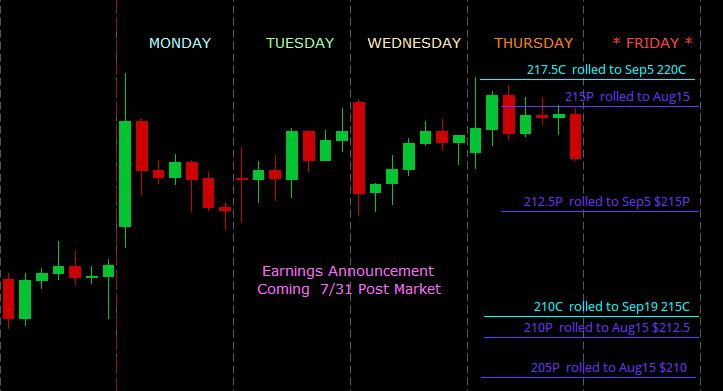Week 7 – July 21-25
It has been 7 weeks now since I initiated coverage and trading on AAPL. There is quite a gap in my updates on Apple as I was on vacation on Colombia for a couple weeks. Trading wasn’t easy, but using my cell phone for trades and a scratch pad actually worked out ok for my AAPL position.
Overall, after 7 weeks, the AAPL position is sitting at a 15.4% gain and the balance that I have feels like this should be something that could continue.
The chart below still needs Friday to cap off the week, but I have already finished my AAPL trades for the week because I have to travel today, and while it does cost some money to move trades before they’re completely done, sometimes it’s needed so that errors are not made because of being distracted, or unable to make some trades.
Read below the chart for some explanations.

All trades this week were profitable except for one, adding to the bank of gains for the week. The only trade that had to be “Red Rolled” was the $210 short call which got pressured because of the sudden lift in price this week on AAPL. In order to get credit on the roll, I had to move it all the way out to Sep 19th $215.
5 of the 7 trades this week returned over 90% on their sale versus cost. One was 49% gain, but notably, that was a trade that previously was a “loss” that was rolled forward. This is basically one of the main pillars of my theory in rolling losers until they become winners. In this case, it was only one roll, or one period of carrying a previous loser forward before it became a winner. This month I began to actually include a tag on any trades that are considered a “Red Roll” adding a #1 or #2 in order to see just how many rolls does one have to do before a loser turns into a winner.
 A “Red Roll” is basically a trade that has gone bad. There are two ways to handle this, one is closing the old trade as is, and carrying the entire roll cost into the new trade. The other method is to close the old trade flat, basically splitting the cost of rolling the trade forward by recording part of it in the rear view mirror, and part of it in the forward looking new trade.
A “Red Roll” is basically a trade that has gone bad. There are two ways to handle this, one is closing the old trade as is, and carrying the entire roll cost into the new trade. The other method is to close the old trade flat, basically splitting the cost of rolling the trade forward by recording part of it in the rear view mirror, and part of it in the forward looking new trade.
At the end of the day, no matter how I do the accounting, profit is made up of money coming in minus money going out. The practice of documenting it in a certain way just helps mentally to decide when closing or rolling a trade whether it needs an adjustment in one direction or another to continue on the path to success.
UNH Week 11
United Heath Group Week 11 – September 12, 2025 There never seems to be a dull moment with this company. This blog is about knowing when to eject from the position, and why. Learning from the events, and looking back it’s easy to see where I should have done a few things differently, but in …
<a href="https://www.optionslinky.com/unh-week11/"
AAPL Week 11
Week 11 – August 22, 2025 What a spectacular time to be trading. There is a lot to learn from what goes on in this time period, and it’s never boring. I put up a 30 day chart for Apple just to show all that’s happened in the last month. At the onset of August …
<a href="https://www.optionslinky.com/aapl-week-11/"
AAPL Week 9
Week 9 – August 8 2025 This week Tim Cook visits the white house, and kisses the hand of Donald Trump. The results or reaction in AAPL stock is unmistakable a direct corelation between the visit, and the favor that Apple stock has found with investors. When I initiated coverage back in June, the price …
<a href="https://www.optionslinky.com/aapl-week-9/"